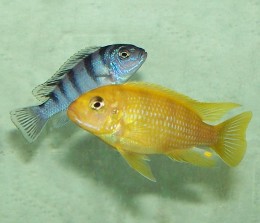Kenyi Cichlid
(Maylandia Lombardoi)
Pseudotropheus Lomardoi
Golden Zebra Cichlid
Kenyi Mbuna
 Kenyi Cichlid (Maylandia Lombardoi) |
Size: 5-6 Inches Temp Range: 75°F to 82°F pH Level: 7.6 to 8.9 Lifespan: 8 to 12 years Tank Size: 50 gallons Diet: Pellet, Flake, Vegetable, Live Difficulty: Moderate |
Geographic History
These interesting fish comes from Lake Malawi in Africa. They can be found on the rocky shorelines around Mbenji Island and Nkhomo Reef.
Enviornment
The Kenyi Cichlid prefers a sandy or fine gravel substrate with lots of larger rocks scattered around. Some of the rocks should be stacked to form caves so that they will have dark areas to hide. Be sure to leave quite a bit of open area in the middle of the aquarium for swimming room. These fish like to graze on algae, so allowing some to grow in your aquarium will be necessary.
Compatibility
These colorful fish are very aggressive and should only be kept with other aggressive Malawi Cichlids of similar size. They do not mix will with other species that are of similar color and pattern. Only one male should be present in your aquarium, unless your tank is very large.
Sexing
Both male and female Kenyi Cichlids are pale blue with dark bands when they are juveniles. Adult males will become a bright yellow with spots on their anal fins. Adult females are a brilliant blue, sometimes with black bands.
These fish can also have some variations in color depending on social circumstances in the aquarium. Sub-dominant adult males may keep their juvenile blue colors when multiple males are kept together. Mouthbrooding adult females may exhibit signifigant yellow coloring soon after spawning.
Behavior
Kenyi Cichlids will spend a lot of time scraping algae off of rocks, driftwood, and aquarium glass. The males will chase the females during daylight hours. Having many females and just a few males will reduce overall stress in their community group.
The males tend to develop micro-habitat territories, by digging beds in the substrate, and will actively defend them from other males. To reduce aggression in aquariums under 100 gallons, only one male is advised. Stocking a large group of other aggressive Malawi Cichlids may suppress male territory formation and overall aggressiveness.
Breeding
Kenyi Cichlids should be spawned in a large breeding tank. A sandy substrate with many large, flat rocks should be provided. Place one male and at least three females in the tank and feed them vigorously with green vegetables to induce spawning. Excellent pH and water quality will be required.
The males will initiate spawning by dancing around in front of the female. If she is ready to spawn, she will follow him to a bed that he has previously dug in the substrate.
Once the breeding pair have reached the spawning bed, the female will lay 10-20 eggs in it. She then promptly scoops the eggs into her mouth. While she is doing this, the male will rub the spotted area near his anal fin in front of her mouth. These spots trick the female into thinking they are eggs. When she goes to gather the spots in her mouth, the male fertilizes the eggs that she has already scooped up. This behavior will be repeated several times during the spawning.
The eggs hatch in a few days, and the female protects the fry by keeping them in her mouth for about a month. The fry will leave her mouth to feed on baby brine shrimp and crushed flake. The female will stay close to the fry and allow them to swim into her mouth again if they feel threatened. Males have no part in the protection of the fry after spawning concludes.
When the eggs have hatched, take care to not remove the female from the aquarium where her fry were spawned. She may then become stressed and eat the fry.
For more information, go to Wikipedia's Kenyi Cichlid page.





